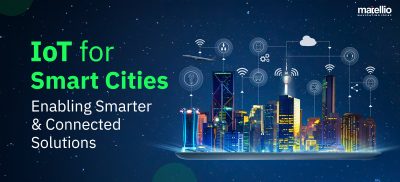
Internet of Things (IoT) has been gaining a lot of popularity among businesses of all sizes in the last few years. From widespread IoT implementation in organizations to custom IoT software development, companies from various industries are investing heavily in IoT. Thanks to the decreasing costs of quality IoT devices and sensors and the massive need for digital transformation around the globe due to the Covid pandemic, IoT and custom enterprise software development are the most sought-after technologies in the world right now.
According to the stats, the global IoT spending, which was $749 billion in 2020, is expected to reach $1 trillion in 2022. These numbers clearly demonstrate a steadily growing corporate and consumer interest in IoT technology.
Almost all industries have embraced IoT. From manufacturing and media & entertainment to healthcare and military, IoT has revolutionized how we do business and interact with our customers. And when paired with technologies such as AI and ML, IoT has almost endless potential.
IoT software solutions are used by offices big and small to streamline their processes and become more productive. Hospitals and clinics use IoT sensors and IoT software solutions to improve their efficiency and enhance their services.
Furthermore, many companies use IoT to help them market their products to the right customer base. IoT-based marketing tools are a growing trend that can help businesses increase their revenues and customer experiences.
So, if you are wondering how you can develop a custom IoT-based marketing tool for your business, you’ve come to the right place. In this article, we will learn the benefits of IoT for marketing teams, how IoT and marketing teams can work together to build better marketing plans and policies, and how you can develop an IoT-based marketing solution for your company.
IoT in Marketing
In the internet age, data is the key to a successful business. Our world today runs on massive amounts of customer and business data. Everything we do online is recorded and used by various companies and enterprises to transform their offerings according to our preferences.
Due to the incredibly competitive nature of the business world, companies are constantly fighting to get new customers and retain the ones they have. The challenge is to make sure you are continually giving value to your customers. If you slack off just a little bit on this front, then some other business will tear customers away from you.
Perhaps no other department in any organization understands the value of data and proper data analysis than the marketing team. It is a big part of their job to sift through the massive amounts of customer data, figure out what they want and find the best way to promote their services and products. And IoT makes this process significantly easier.
As with most technologies these days, the foundation of IoT lies in two things: internet connectivity and data.
Experts describe IoT as a network of internet-enabled devices that can share data and instructions between them, thus enabling real-time data collection and task automation. The collected data is then sent back to the servers to be processed, stored, and analyzed. Additionally, marketers can monitor and manage this data with the help of an IoT management software solution.
Let’s try to understand IoT in marketing with the help of the following example:
A retail store’s marketing team is trying to figure out why 40% percent of the people that come into their store in a day leave without buying anything. They want to bring this number down to 20%, and for that, they have decided to use IoT. With the help of well-placed CCTV cameras and IoT sensors, they can monitor their customers and their entire buying journeys. Right from the time they enter the store till the time they leave. The real-time data is stored in the servers, where it is analyzed to detect trends and learn customer behavior. For instance, what part of their store sees the most traffic, what type of demographic or age group comes to the store and at what time or on which occasions, how long it takes for a customer to checkout, etc. Based on all this data, marketers can determine the right way to target their customers and make their experience more enjoyable and streamlined. For example, the part of the store that sees the most traffic is the best place to advertise the products for a certain type of demographic. Furthermore, if they are having trouble selling a certain product in demand among a certain customer base, they can change its location and make it more accessible to the users. In such a way, with the help of data analysis and IoT, marketers can figure out the pain points and come up with creative solutions to increase their revenues.
But IoT is only one part of this picture. Imagine the amount of data the retail store in our example above collects in just one day. It is impossible for a human being to sift through all this data and learn about customer behavior and trends. That is why every good IoT implementation needs a well-trained AI.
AIs use the data to train themselves and give marketers critical insights about the customers. But that’s not it. AIs can also help marketers devise better marketing plans as well. They can learn which products are popular among the people from different demographics, the best way to market to them, etc.
IoT can also be used to enhance customer experience. Many big retail stores keep track of their regular customers. Based on their previous purchases, these stores guide the customers towards the products they might be interested in.
Furthermore, auto-checkout is also becoming very popular. These are automated kiosks using which customers can pay for their purchase without the hassle of long lines.
How to Develop IoT-based Marketing Solutions for your Business?
So far, we have talked about how IoT can help marketers and how they can leverage it to improve customer experience and company revenues. And now, it’s time to learn how you can develop an IoT-based marketing solution for your business. Below is all the information you need to get started with your IoT implementation journey.
1. Identify your Pain Points
IoT implementation is a vast spectrum of services and solutions you can develop. But not all of them will benefit you or your business. Before you move any further, you need to figure out what the requirements of your business are.
What pain points do you want to address with the help of IoT?
Every business is different and requires a custom IoT solution to address its problems. It’s not just about the pain points, though. IoT implementation usually causes a lot of disruption in the normal workflow of any business. It impacts productivity and revenues. So you must figure out which problem you should address first. If you try to implement IoT on all fronts, the disruption and risk will be greater. So you should make a priority list and cross off one priority at a time from it. This will give your employees a chance to get used to the new infrastructure and prevent you from losing too much time and money.
To get the most out of your IoT-based marketing solution development, you must also decide what type of data you need to build your strategies. It will help you determine what kind of IoT devices and device management software you will require.
All of this information will prove vital throughout your IoT development process, so make sure you commit to it completely.
2. Do your Research
Once you know your pain points and requirements, it’s time to look for possible solutions.
As we discussed earlier, IoT is a big spectrum with countless offerings. But not all of them meet your requirements. Therefore, you have to conduct a thorough market study and learn what options are available to you.
A great way to do so is by competitor analysis. Take a look at your competition and learn how they are solving their marketing problems using IoT. It will not only tell you what to do but also what not to do. You can learn from their mistakes and build even better solutions.
Keeping up to date with the latest advancements in technology is also beneficial. For instance, if a new cloud IoT services provider on the market offers premium cloud IoT solutions at a more cost-effective rate, you must know about it.
To improve customer experience, you can conduct interviews and surveys to determine their expectations. For instance, in the case of our earlier retail store example, you can take a small face-to-face interview of willing customers and ask them how you can improve your services. Also, you can take digital surveys or ask for suggestions to get more ideas.
Read More: Internet of Behavior (IoB) And Its Effects on Your Life and Business
3. Build a Plan
IoT implementation is a big financial undertaking. Not only will you be investing a significant amount of money, but you will also be disrupting your business’s normal workflow, which will hurt your revenues. So it’s imperative that you use all the knowledge you’ve gathered in the first two steps and build a sound IoT development plan.
In this phase, you will have to figure out your budget and timeline. Don’t forget to consider device installation costs while setting the budget. While you will need to work closely with your technology partner to build the final development plan, it’s best if you have the basics of your solutions and your requirements clear first.
4. Hire an IoT Development Company
Of course, to build a proper development plan, you will need the insights of an experienced IoT developer and consultant. They will take a look at your requirements and will be able to give you the exact time and cost estimations. Furthermore, with the help of IoT experts, you will be able to build a better development plan or come up with new ideas.
IoT implementation and development is a complicated process, and you will need an IoT expert you can trust by your side. There are plenty of IoT development companies that offer great services at cost-effective rates. But you must look for those who have experience with the type of marketing solution you need. You can use sites like Clutch to find everything you need to know about these companies. Also, don’t forget to check out their websites. Good developers like to flaunt their achievements and success stories in their portfolios. So browse through them to see what projects they have worked on in the past.
Also Read: How to Hire an IoT Development Company?
5. Develop your IoT-based Marketing Solution
The development phase can be extremely taxing without a good IoT solution developer. But an experienced developer with well-built and tested development strategies should be able to make the entire development process much easier and streamlined. Depending on the type of solution and how much mobility you need, you can develop a full-fledged legacy software or a cloud solution. To enhance your accessibility, you can even build a mobile application to help you always be in contact with your IoT devices.
The development of an IoT-based marketing solution will go hand-in-hand with device installation. The way IoT development usually works is that you ask your developer to deliver a small POC. If the results are satisfactory, only then the next step is taken, and the development begins.
6. Test and Deploy your Solution
Once your IoT implementation and development are finished, they must be tested to ensure that there are no bugs in the software solution. Furthermore, rigorous security testing is required. As you will be dealing with a huge amount of customer data, you will need to ensure there are cracks in your security.
Once the testing is done, you will deploy your solution. It will take a couple of days for the entire implementation to work perfectly. For the first few days, you will be dealing with bug fixes and patches. Once your implementation has been deployed, you can work on improvements and upgrades.
Conclusion
The global IoT market is skyrocketing, thanks to the latest advancements and the drop in the production cost of IoT sensors. IoT implementation is not as expensive as it used to be a couple of years ago. Furthermore, as companies are racing to finish their digital transformation as soon as possible, IoT has become one of their greatest weapons. IoT can transform how marketing teams work and target their customers. Learning about customer behavior and their buying habits helps them build smarter marketing plans and increase the company’s overall revenues.
If you are looking to develop a custom IoT-based marketing solution for your company, then Matellio Inc is the right choice. Our team comprises talented and experienced IoT experts and IoT developers. We employ the agile development methodology to provide the best customer experience and ensure maximum transparency. Our development services are highly scalable and designed to fit any budget.
If you want to learn more about our IoT development services, contact us!





